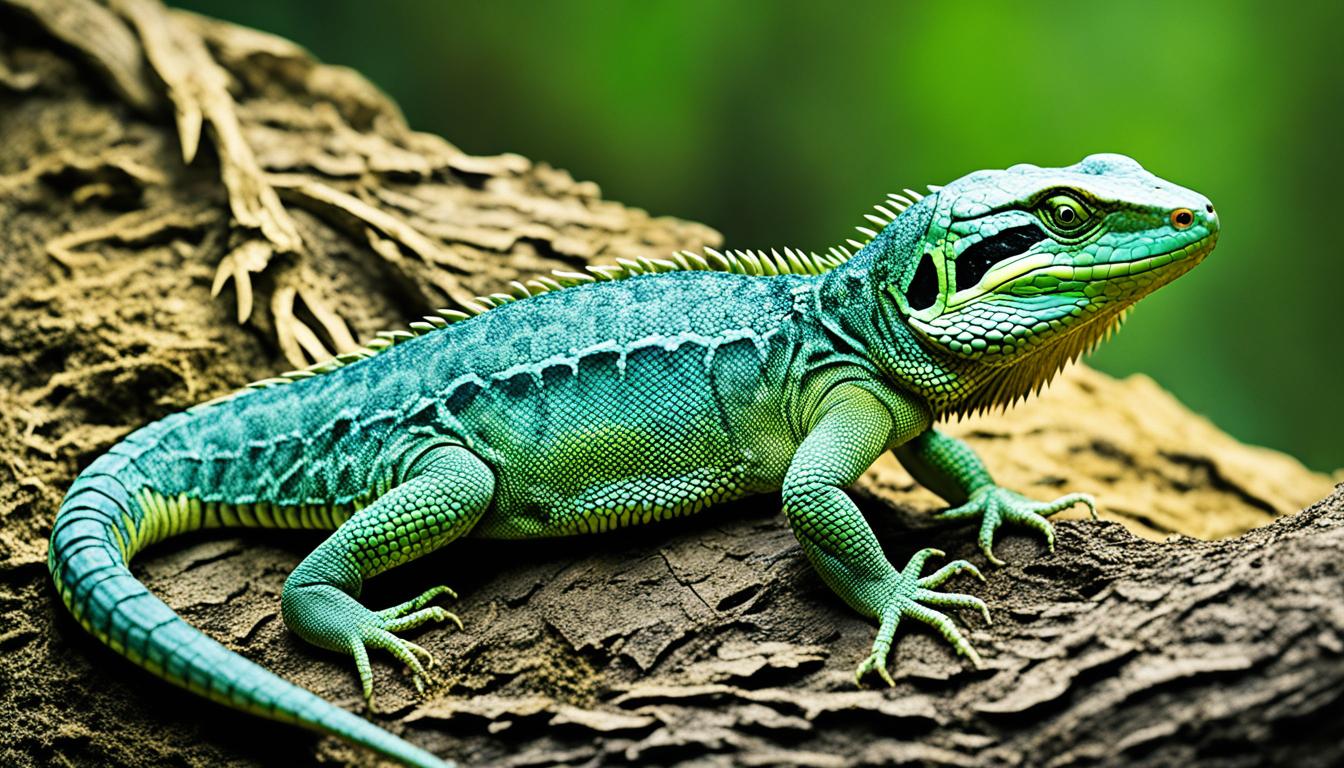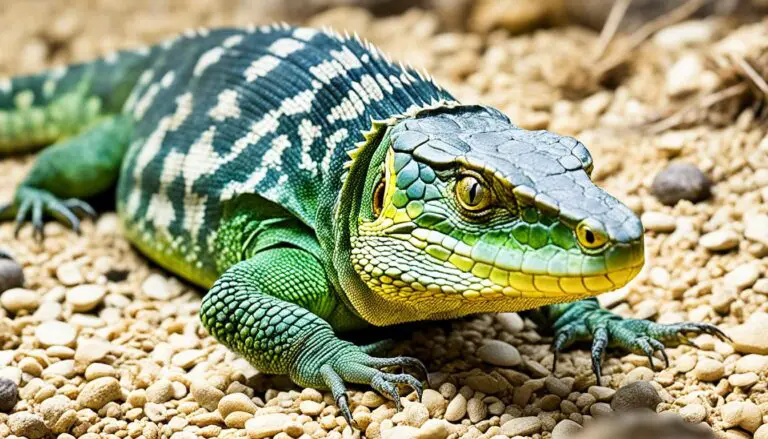Metabolic Bone Diseases in Reptiles & Amphibians
Did you know that diet-related metabolic bone diseases (MBDs) are a big issue among reptiles and amphibians?
These diseases mainly affect the bones of our beloved pets. They make bones weak and easy to break, causing a lot of pain. MBDs are more common than you might think. They are found in reptiles and amphibians all around the world.
Key Takeaways
- Metabolic bone diseases (MBDs) are a common problem in reptiles and amphibians, leading to weakened bones.
- Poor diet and care, including inadequate levels of calcium, phosphorus, and vitamin D3, are often the underlying causes of MBDs.
- Reptiles and amphibians of all ages can be affected by MBDs if their specific dietary and environmental needs are not met.
- Recognizing the symptoms of MBDs, such as decreased appetite, lethargy, and broken bones, is crucial for early detection and treatment.
- Prevention through proper diet, calcium supplementation, UVB lighting, and appropriate temperature and humidity levels is essential for maintaining the bone health of reptiles and amphibians.
Symptoms of Metabolic Bone Disease in Reptiles and Amphibians
Recognizing the signs of metabolic bone disease (MBD) in reptiles and amphibians is key to their health. These signs vary, but understanding common symptoms is crucial. This helps owners spot issues early and get their pets the necessary care.
Signs of MBD can include:
- Less interest in food
- Being slow or inactive
- Losing weight
- Fractures
- Legs that feel soft and bendy
- A swollen jaw or legs
- Shells that are soft or not the right shape (in turtles and tortoises)
- Trouble walking or moving
- Muscle spasms
- Stiff muscles
- Problems with urine or poop
These symptoms can be mild at first but get worse without treatment. MBD can become serious, even causing seizures or death.
Owners must watch their pets for these signs. If they see any, they should take their pet to a vet right away. Early help improves the chance of recovery from MBD.

Causes of Metabolic Bone Disease in Reptiles and Amphibians
The reasons behind metabolic bone disease in reptiles and amphibians often come down to not enough food or the wrong kind of care. These creatures need certain amounts of calcium, phosphorus, and vitamin D3 for strong bones. Without these nutrients, or the chance to take them in right, they can get metabolic bone disease.
A big problem is giving them food that’s low in calcium, phosphorus, or vitamin D3. This can up the chances of them catching metabolic bone disease. Not getting enough calcium in their food is bad because reptiles and amphibians need more calcium than other pets. And if they don’t get enough sunlight that produces vitamin D3 or the right artificial light, it makes them even more likely to suffer from MBD.
Also, having the wrong temperature and humidity in their living space can lead to metabolic bone disease. These animals really on their environment to regulate their body temperature. If it’s too hot or cold, it can mess with how they process food and nutrients. Plus, not enough humidity can mess with their ability to take in nutrients properly.
And it’s not a one-size-fits-all problem. Some reptiles and amphibians don’t deal well with issues because of their unique needs. Growing young ones, and those animals making eggs or babies, need more calcium and other nutrients. Stress from things like getting sick or moving to a new home can also make MBD more likely.
Reptile Nutrition Deficiencies:
The lack of important food elements can really hurt reptiles and amphibians. Missing out on things like calcium, phosphorus, and vitamin D3 can damage their bones, causing many health problems. It’s crucial to provide them a diet that’s diverse and fits their needs to keep them healthy and avoid metabolic bone disease.
Reptile Health and Amphibian Health:
Keeping reptiles and amphibians healthy is not only about what they eat. It’s also about having the right surroundings, caring for them properly, and checking in with a vet. Making sure they have the right diet, light, heat, and moisture levels is key. This attention to detail is what keeps them in good shape.

| Causes of Metabolic Bone Disease in Reptiles and Amphibians | Severity | Prevention |
|---|---|---|
| Poor diet | High | Provide a balanced diet with appropriate levels of calcium, phosphorus, and vitamin D3. Offer gut-loaded or supplemented feeder insects. |
| Lack of calcium supplementation | High | Regularly supplement their diet with calcium to ensure adequate intake. |
| Inadequate UVB lighting | High | Provide proper UVB lighting to support vitamin D3 synthesis and calcium absorption. |
| Improper temperature and humidity levels | Medium | Maintain optimal temperature and humidity within their habitat. |
| Youth | Medium | Ensure young animals receive appropriate nutrition for growth. |
| Reproduction | Medium | Adjust their diet to meet increased nutritional demands during reproduction. |
| Stress | Medium | Minimize stressors and provide a stable environment. |
Diagnosis of Metabolic Bone Disease in Reptiles and Amphibians
Finding out if a reptile or amphibian has metabolic bone disease (MBD) isn’t easy. Vets do a full check-up and use tests. They check the animal’s body, blood, and even the things the animal eats and how it’s kept. This helps them know if the MBD is there and why it happened.
The vet looks for odd things in the bones during the check-up. They might use X-rays to get a closer look at the bones. This shows if the bones are not as strong as they should be.
Vets also do blood tests. These can show if the animal has enough of certain important things like calcium. If these levels are off, it could mean the animal isn’t eating right. The vet might also look at the animal’s poop. This can show if the animal has any worms that might be messing with how it digests food.
Checking what the animal eats and how it’s kept is very important. Vets look at the food and where the animal lives. This includes the temperature, light, and how big the home is. They do this to figure out if the MBD is because of what the animal is eating or its home.

Finding metabolic bone disease early is key to treating it right. If the diet and home of the animal are fixed, they can get better. This way, their bones and health will improve.
| Diagnosis of MBD | Methods |
|---|---|
| Physical examination | Assess for signs of bone abnormalities, deformities, and fractures. |
| Radiographs | Visualize bone structure to identify irregularities in density and formation. |
| Blood work | Check calcium, phosphorus, and vitamin D3 levels for imbalances indicating nutritional deficiencies. |
| Fecal analysis | Assess for gastrointestinal parasites that can impact nutrient absorption. |
| Evaluation of diet and husbandry practices | Review the types of food provided, nutritional content, and living conditions to identify potential deficiencies or imbalances. |
MBD in reptiles and amphibians needs many tests to be sure. Vets look at everything about the animal. This way, they can find the best way to help the pet get better.
Treatment of Metabolic Bone Disease in Reptiles and Amphibians
Metabolic bone disease (MBD) in reptiles and amphibians needs special care to ensure their health. We must fix what they eat and change how we keep them. This can include giving them fluids, calcium, and fixing any urgent health issues.
For the long run, we aim to get their calcium, phosphorus, and vitamin D3 levels right. This means changing their diet, giving them supplements, and the right light. Animals with MBD might need help with pain, to be dewormed, and they may need to be hand-fed.
“The treatment of metabolic bone disease in reptiles and amphibians involves addressing the underlying nutritional deficiencies and improving husbandry practices.”
Eating the right food is crucial. These pets need a lot of calcium to keep their bones strong. Sometimes they need extra calcium which a vet might give them.
They might also need physical therapy and changes to their homes for rehab. Having regular check-ups and X-rays is important to see if the treatment is working. Adjustments can be made as needed.
By focusing on preventing and treating MBD, pet owners help their reptiles and amphibians stay healthy. They can have full, happy lives this way.
Treatment Strategies for Metabolic Bone Disease
| Treatment Strategies | Description |
|---|---|
| Dietary adjustments | Modify the reptile’s or amphibian’s diet to ensure adequate intake of calcium, phosphorus, and vitamin D3. |
| Supplements | Administer calcium, phosphorus, and vitamin D3 supplements to restore and maintain proper nutrient levels. |
| Appropriate lighting | Provide UVB lighting to facilitate the synthesis of vitamin D3 and promote calcium absorption. |
| Pain management | Implement pain management techniques to improve the reptile’s or amphibian’s comfort and well-being. |
| Deworming | Treat and prevent gastrointestinal parasites that can hinder nutrient absorption. |
| Supportive care | Offer hand-feeding and other forms of support to meet the animal’s nutritional needs. |
| Environmental modifications | Make adjustments to the reptile’s or amphibian’s habitat to create optimal conditions for bone health and recovery. |
It’s key to team up with a vet to treat MBD in reptiles and amphibians. A good plan includes changing what they eat, giving them the right supplements, the best light, and extra care. This gives them the best shot at getting better and staying strong.

Recovery and Management of Metabolic Bone Disease in Reptiles and Amphibians
Helping reptiles and amphibians with metabolic bone disease (MBD) requires a lot of care. Each animal’s response to treatment is different. Some might need several months to get better. Others may not recover fully even with treatment.
Setting up the right home for these animals is vital during their recovery. This means keeping the proper temperature and moisture levels. Also, they should have enough UVB light and a balanced diet. Adding vitamin D to their food can help, as lack of this vitamin is often a cause of MBD.
It’s also key to see the vet regularly. The vet will check the animal’s bones and adjust the care plan if needed. They might take X-rays to see how well the bones are healing. This helps the vet decide if the treatment is working.
Good husbandry is crucial for managing MBD. Owners must keep an eye on the temperature and humidity for their animals. The right UVB light helps the reptile make vitamin D, which is important for their bones.
Dietary Considerations for Recovery
Feeding reptiles and amphibians the right food is essential in MBD management. Diets should be rich in calcium and phosphorus. These nutrients are vital for strong bones.
Owners should feed their pets calcium-rich foods like dark greens and fortified insects. Using supplements of calcium and vitamin D3 might also be necessary. It helps meet the reptiles’ needs.
Always check and improve the diet. It’s good to talk to a vet skilled in reptile care for advice on feeding your pet right. A good diet is crucial for helping the animal get better.
Monitoring and Follow-up
As the animal heals, keep a close eye on their health. Regular vet visits are important to check on the MBD recovery. The vet can adjust the treatment plan if needed.
During vet visits, X-rays might be taken to check the bones. These scans can show if there are any new issues. They are a key part of the long-term management of MBD.
Summary
The care and recovery of reptiles and amphibians with MBD take a lot of effort. Creating the right home, fixing diet problems, and checking on bone health are crucial. Good living conditions and care, along with vet visits, can help these animals get better and live well.
Prevention of Metabolic Bone Disease in Reptiles and Amphibians
Preventing metabolic bone disease in reptiles and amphibians requires focusing on the right diet and care. It’s key to place importance on their bone health. This helps avoid calcium deficiency. Here are important points to keep in mind:
1. Balanced Diet
Reptiles need a diet that’s balanced and rich in calcium, phosphorus, and vitamin D3. These are vital for their bones. Make sure feeder insects or food are either full of calcium or covered in supplements.
2. Adequate Lighting
UVB light is essential because it helps reptiles and amphibians make vitamin D3. This is critical for absorbing calcium. Find out the lighting needs for your pet’s species to create the best home.
3. Environmental Conditions
It’s crucial to keep the right temperature and humidity for each species. This helps with their bone health. Always check and adjust their living conditions as needed.
4. Regular Veterinary Check-ups
Seeing a vet regularly is very important. They can give advice on diet and care. They’ll also spot and handle any early signs of bone disease.
By following these steps, you can keep your reptile or amphibian friend’s bones strong and healthy. Being proactive with their care helps avoid bone problems. This supports their skeletal health for the future.
| Prevention Tips for Metabolic Bone Disease | |
|---|---|
| Feed a balanced diet with adequate calcium, phosphorus, and vitamin D3. | ✔ |
| Ensure the presence of proper UVB lighting for vitamin D3 synthesis. | ✔ |
| Maintain temperature and humidity levels within the species-specific range. | ✔ |
| Schedule regular veterinary check-ups and follow their recommendations. | ✔ |
Conclusion
Metabolic bone disease is common among reptiles and amphibians, and it can be serious. But, it’s mostly preventable with the right care and nutrition. Owners should make sure their pets get enough calcium, phosphorus, and vitamin D3.
This means feeding them a balanced diet. You can also use calcium-enriched feeders or dust their food with calcium supplements.
Having the right UVB lighting and a good home is also very important. Check with a reptile vet often. Early discovery and care can prevent or treat bone diseases.
It’s key to focus on what your pet eats and its environment. Doing this will help your pets live long, healthy lives. With good care, reptiles and amphibians won’t suffer from these health issues. It just takes a little effort to keep them well and flourishing.
FAQ
What are metabolic bone diseases in reptiles and amphibians?
What are the symptoms of metabolic bone disease in reptiles and amphibians?
What causes metabolic bone disease in reptiles and amphibians?
How is metabolic bone disease in reptiles and amphibians diagnosed?
How is metabolic bone disease in reptiles and amphibians treated?
What is the recovery and management process for metabolic bone disease in reptiles and amphibians?
How can metabolic bone disease in reptiles and amphibians be prevented?
Source Links
- https://pubmed.ncbi.nlm.nih.gov/20682425/
- https://www.petmd.com/reptile/conditions/musculoskeletal/metabolic-bone-disease-mbd-reptiles
- https://www.birdexoticsvet.com.au/new-blog/2020/6/16/metabolic-bone-disease-in-reptiles
Peter Stones is the founder of Exotic Pets Place, the leading online resource for exotic pet care information.
With over 10 years of hands-on exotic pet ownership experience, he is deeply passionate about sharing his expertise to help others properly care for their unusual pets.
When he's not writing extensively researched articles or connecting with fellow exotic pet enthusiasts worldwide, you can find Peter at home tending to his own beloved menagerie of exotic animals.







